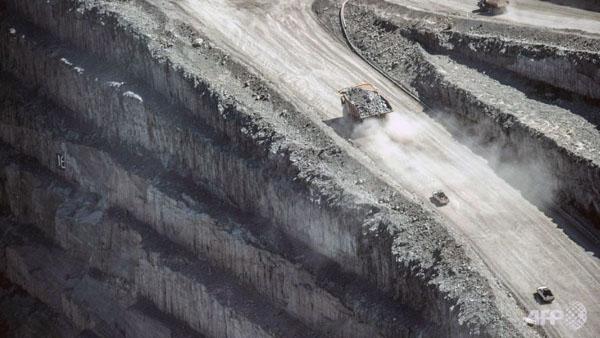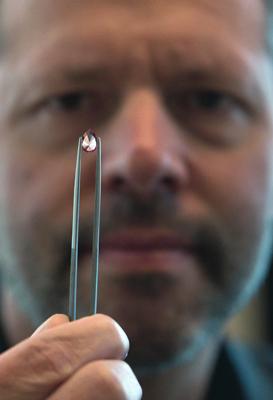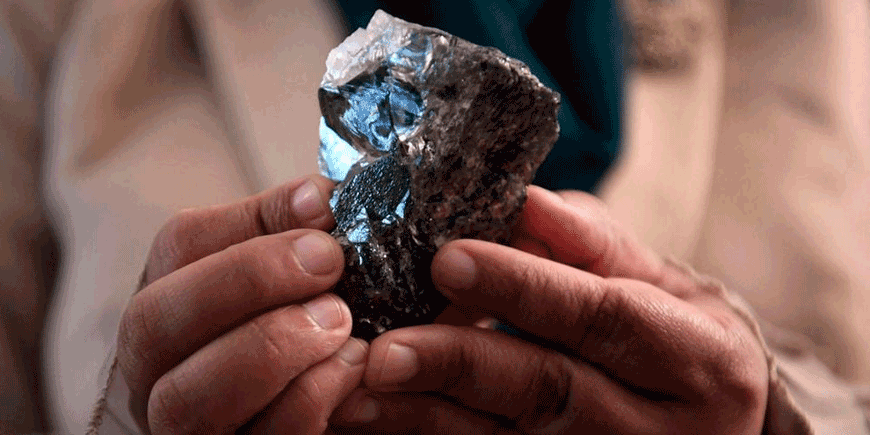You are here
Digging deep in South Africa as diamond hunt gets tougher
By AFP - May 08,2016 - Last updated at May 08,2016

De Beers spent 25 years digging a 450-metre deep by one-kilometre wide hole to access diamond-rich rock from the surface at the Venetia mine (AFP photo)
VENETIA MINE, South Africa –– Proof that diamonds are getting harder to find can be seen in the South African bush, where one of the world's largest mining companies is spending $2 billion tunnelling beneath a vast open-pit mine.
De Beers spent 25 years digging a 450-metre deep by one-kilometre wide hole to access diamond-rich rock from the surface at the Venetia mine, close to the border with Zimbabwe and Botswana.
Now a whole new underground mine is being constructed underneath the hole to reach diamonds more than 1,000 metres below ground — a big bet by De Beers that their investment will reap decades of profit.
"We are in very challenging times," Ludwig Von Maltitz, the mine's general manager, told AFP on the edge of the cavernous open-pit as trucks rumbled up to the processing plant.
"Worldwide, the easier diamond sources have probably been found but, with this resource here, we hope we have something that can extend well into the future."
As the hunt for diamonds becomes tougher, mining companies must go to greater lengths — and absorb higher costs — to secure the ultimate precious stone and symbol of love.
"Across the globe, the big diamond deposits have been exploited, and I don't see any big new mines coming online," Peter Major, mining specialist at Johannesburg-based Cadiz Solutions, told AFP.
"We are often told that the growing world population, combined with the increasing difficulty of finding diamonds, will mean prices always rise, but we will see. Many producers are losing money.
"The project at Venetia is stupendous — especially as very few other firms are investing in mining in South Africa."
In recent years, diamond prices have fluctuated sharply.
After the global economic crisis in 2008, prices recovered quickly to hit a peak in 2011 before falling about 20 per cent to slightly below their current rate.
Amid such swings, mining companies must judge whether it is profitable to prospect for diamonds in increasingly difficult geological conditions, or in unstable countries such as Angola and the Democratic Republic of Congo.
Are diamonds forever?
Reflecting widespread uncertainty in the industry, De Beers — the world's largest supplier of diamonds by value — shut diamond mines in Canada and Botswana last year.
It also sold its last mine in the South African town of Kimberley, where the diamond industry was born and where De Beers was founded in 1888 by British colonialist Cecil Rhodes.
But the Venetia mine is set to become one of the world's five biggest diamond mines after its conversion from open-pit to underground operations is finally completed in 2022.
Current predictions suggest the mine will then operate until at least 2043.
"The troughs and the peaks [of diamond prices] happen more frequently now but I am optimistic," said Von Maltitz.
"If we can do it well enough, I can't see why mining should not be a lucrative business going forward."
Demand for diamonds over the last decade has been driven by a new generation of buyers in China and India that have adopted the tradition of giving diamond engagement rings.
Latest figures suggest that such new markets are fragile.
De Beers last month reported that global demand for diamond jewellery grew 2 per cent in 2015 with growth strongest in the United States and China.
But a dip in India and across the Gulf region pointed to weakening growth in many emerging markets.
"China and India drove diamond prices up, along with speculation that the growth rate would continue indefinitely," industry analyst Paul Zimnisky said, speaking from New York.
"People got overly optimistic and greedy," he said.
Zimnisky believes "it is misleading to say we are running out of diamonds" as "when prices rise, mines that were uneconomic become profitable".
However the industry cannot react that quickly to a rise in demand and prices.
Zimnisky said, "it takes time to get a new diamond mine started — perhaps 10 years. That is what makes the $2 billion expenditure at the Venetia mine so significant."
A fresh challenge that the industry faces is the emergence of synthetic diamonds, which are predicted to rapidly fall in price over the next 10 years as the manufacturing technology and quality improves.
But mining companies hope a real diamond dug out of the deep ground will still be the last word in luxury long into the future.
"The Venetia project is definitely worthwhile to pursue," said Richard Grieg, a senior site manager at the mine, which employs 4,500 people.
"We are already re-training the miners to enable them to work in the very different conditions underground."
Related Articles
GABORONE — One of the world's largest diamonds ever unearthed, a rough 2,492-carat stone, has been found in Botswana, a Canadian minin
HONG KONG — De Beers, the world's largest diamond producer, said Monday the economic slowdown in China and a strong US dollar meant a "chall
GABORONE — Botswana's President Mokgweetsi Masisi on Sunday warned that his country may sever ties with diamond giant De Beers if talks to r

















